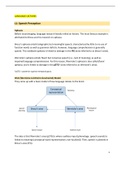LANGUAGE LECTURES
L1: Speech Perception
Aphasia
Before neuroimaging, language research heavily relied on lesions. The most famous example is
attributed to Broca and his research on aphasia.
Broca’s aphasia entails telegraphic but meaningful speech, characterized by little to no use of
function words as well as grammar deficits. However, language comprehension is generally
spared. This nonfluent aphasia is linked to damage in the IFG (now referred to as Broca’s area).
Wernicke’s aphasia entails fluent but nonsense speech (i.e., lack of meaning), as well as
impaired language comprehension. For this reason, Wernicke’s aphasia is also called fluent
aphasia, and is linked to damage in the pSTG* (now referred to as Wernicke’s area).
*pSTG = posterior superior temporal gyrus
WLG (Wernicke-Lichtheim-Geschwind) Model
They came up with a basic model of how language relates to the brain:
Conceptual Meaning
representation
Speech Broca’s area Wernicke’s area Phonological
planning lexicon
Speech output Auditory input
The idea is that Wernicke’s area (pSTG) is where auditory input (phonology: speech sounds) is
linked to meaning (conceptual word representation; non-localized). Then, speech is planned in
Broca’s area (IFG).
1
,So, Broca’s area underlies speech production whereas Wernicke’s area underlies speech
perception. We now focus on speech perception: how auditory input (sound) is linked to
meaning.
Dual Stream Model by Hickok and Poeppel
This model will be the main focus of this lecture, as it is more accurate and complete than the
WLG model. The dual stream model suggests the involvement of a number of brain regions in
speech processing.
Speech processing:
Speaking and understanding proceeds rapidly and unattentively, despite a lot is happening at
the cognitive level.
Speech:
Speech can be broken down into its components:
Sentences > Propositions > Words > Morphemes > Phonemes
2
, 1. Sentences
e.g., “Then once you have examined the city you can get a nice contrast to the surrounding countryside”.
2. Propositions
meaningful grammatical units within a sentence: a sentence can be made up of multiple propositions,
each being a complete grammatical unit.
e.g., “Once you have examined the city” and “You can get a nice contrast to the surrounding countryside”.
3. Words
e.g., “once”, “city”, “you”.
4. Morphemes
smallest meaningful units of language that cannot be further divided or analyzed: doing so would cause
the morpheme to lose its meaning. Therefore, the morpheme conveys meaning in itself. A word can be
made up of one or more morphemes.
e.g., “control” is made up of one morpheme, while “uncontrollably” is made up of four morphemes (un –
control – able – y).
5. Phonemes
smallest linguistic units in speech that change the meaning of the utterance. So, phonemes are the basic
(speech) sounds of a language: every language has its sets of phonemes, from which you can build the
entire language.
Sometimes, the phoneme is a morpheme (e.g., -s, -y).
Minimal pairs allow to discern the phonemes making up a particular language. This works by
changing one phoneme of a word and seeing whether the meaning changes. For instance,
changing “rot” into “lot” alters the meaning of the word, indicating that /r/ and /l/ are different
speech sounds in English.
Difference between phonemes and morphemes: morphemes have meaning in themselves, but if you change
the constituent phonemes, the meaning of the morpheme changes.
3
, Phonology
We now look at the determining factors that describe the different consonants and vowels that
make up a language.
Consonants:
• Manner of articulation
e.g., fricative (f, s) or plosive (b, p)?
• Place of articulation
depending on where the plosive/fricative is generated, different phonemes result. So, different
locations within the mouth lead to different phonemes.
• Voicing
whether the sound is voiced or unvoiced: are the vocal cords activated or not?
A voiceless consonant (e.g., t) doesn’t make vocal cords vibrate, while a voiced consonant (e.g., d) does.
Otherwise, the two phonemes can be completely identical (in terms of place and type of articulation): the
voicing change can dramatically alter the resulting phoneme. Examples are /s/ and /z/, or /t/ and /d/.
Vowels:
• Tongue position
whether it is high/low or back/front. A given tongue position creates a ‘chamber’ within the mouth, which
determines the vowel to be generated.
Variation in Speech Sounds
There are many factors affecting the precise acoustic realization of a phoneme (e.g., age, sex,
dialect, speaking rate, coarticulation).
In fact, the same vowel (spoken in isolation) can have different acoustic realizations (physical
properties) depending on the speaker.
Coarticulation (speech context) is a major determinant of what a phoneme sounds like: the
acoustic realization of phonemes is influenced by the surrounding phonemes. This is because,
as we speak in a continuous fashion, the shape of the mouth preceding a given sound
influences the realization of the next phoneme.
So, phoneme perception is challenging, given the context-dependent variations in phonemic
properties. How do we then effortlessly have a constant experience?
4




